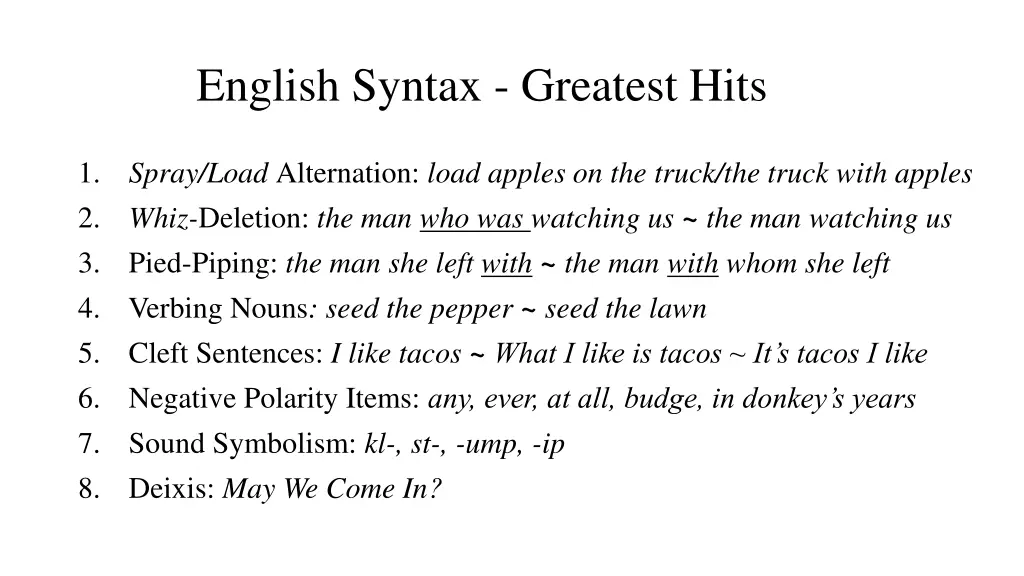
English Syntax Highlights: Verb Structure and Clause Patterns
Explore key syntactic structures in English including Spray/Load Alternation, Whiz-Deletion, Pied-Piping, and more. Understand how verbs interact with objects and how clauses can be modified for clarity and emphasis in sentences.
Download Presentation

Please find below an Image/Link to download the presentation.
The content on the website is provided AS IS for your information and personal use only. It may not be sold, licensed, or shared on other websites without obtaining consent from the author. If you encounter any issues during the download, it is possible that the publisher has removed the file from their server.
You are allowed to download the files provided on this website for personal or commercial use, subject to the condition that they are used lawfully. All files are the property of their respective owners.
The content on the website is provided AS IS for your information and personal use only. It may not be sold, licensed, or shared on other websites without obtaining consent from the author.
E N D
Presentation Transcript
English Syntax - Greatest Hits 1. 2. 3. 4. 5. 6. 7. 8. Spray/Load Alternation: load apples on the truck/the truck with apples Whiz-Deletion: the man who was watching us ~ the man watching us Pied-Piping: the man she left with ~ the man with whom she left Verbing Nouns: seed the pepper ~ seed the lawn Cleft Sentences: I like tacos ~ What I like is tacos ~ It s tacos I like Negative Polarity Items: any, ever, at all, budge, in donkey s years Sound Symbolism: kl-, st-, -ump, -ip Deixis: May We Come In?
Spray/Load Alternation There is a class of verbs with similar meaning involved with placing and distributing various kinds of things that share a grammatical rule. This rule allows these verbs to occur with two kinds of object Noun Phrases, representing moving things, and the places they move to. Either NP may be the direct object, but the other NP needs a preposition. She drizzled the salad with oil. ~ She drizzled oil on the salad There is another class of similar verbs where this rule does not work. She filled the cup with water ~ *She filled water into the cup.
Whiz-Deletion Relative clauses usually begin with a Wh-word (which, who, where, etc.) the man who is coming to dinner, the bridge which is standing there If the wh-word is the subject of the relative clause, and if the first auxiliary verb is a form of be (as in the examples above), they may be deleted together by the rule of Whiz-Deletion: the man coming to dinner, the bridge standing there Whiz-Deletion is extremely common; it s the source of most participles and prepositional phrases following the nouns they modify: an iron in the fire, the last man standing, a tree 250 years old
Pied-Piping A wh-word can be the subject of a relative clause, or an object of a verb or preposition: a book which she read __, a man whom she talked to __ A preposition in a relative clause with a wh-word as object may optionally be moved to the front, along with its object: a man to whom she talked This movement of extra material with the wh-word in a relative clause is referred to as Pied-Piping the material; this can get quite extensive: the books which the Chair decides on the lettering in the titles of the books of which the Chair decides on the lettering in the titles the books in the titles of which the Chair decides on the lettering the books the lettering in the titles of which the Chair decides on
Cleft Sentences Any sentence can be expanded to indicate emphasis and viewpoint. Of the many rules with that function, a number are called Clefts because they divide the sentence into two parts balanced on a fulcrum. Usually a dummy element like it or what is involved: It-clefts: It was Bill that/who passed the math test It was the math test that/which Bill passed Wh-clefts: What Bill passed was the math test What Bill did was pass the math test
Negation and Negative Polarity Negative Polarity words and phrases only occur in a negative context: She hasn tever been there ~ *She has ever been there. She hasn t been there in weeks ~ *She has been there in weeks She refused to budge an inch ~ *She agreed to budge an inch Negative Triggers are words, phrases, and constructions that license NPIs Few have seen it at all ~ *A few have seen it at all She doubtshe s all that smart~ *She claims he s all that smart It rarely takes long to do ~ *It often takes long to do Only Bill has arrived yet ~ *Even Bill has arrived yet Has Bill arrived yet?~ *Bill has arrived yet (NPIs are OK in questions)
Sound Symbolism Monosyllabic words like sting, clip, black, and plump have two parts: Assonance: st-, kl-, bl-, and pl-+Rime: -ing, -ip, - k, and - mp Sometimes these word chunks have meanings and can combine: clip, close, clump, cling, and others things that go together stiff, stack, sting, stump, and others (vertical) 1-Dimensional things blood, bloat, blimp, blast, and others contained fluid plump, plaque, plank, pleat, and others 2-D thick things hump, bump, sump, slump, and others 3-D concave or convex things blip, flip, dip, lip, and others small 3-D parts of 2-D things
84 Simplex Words with Assonance KL- Coherence 62/84 = 74%
Deixis May We Come In? May We Come In ?
